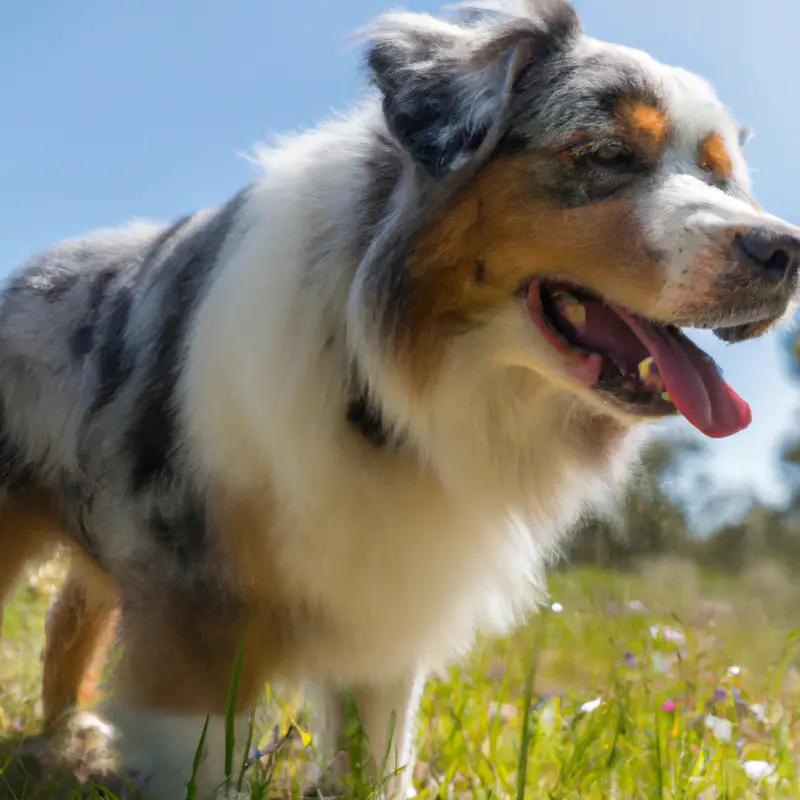How Do Australian Shepherds Handle Being Left Alone In a Yard With Ducks?
Key Takeaways:
- Australian Shepherds typically exhibit herding instincts when left alone with ducks in a yard.
- Proper training and socialization are crucial to ensure Australian Shepherds do not harm ducks when unsupervised.
- Providing mental stimulation and exercise can help prevent behavioral issues in Australian Shepherds left alone with ducks.
- Each Australian Shepherd’s behavior may vary, so careful observation and understanding of individual traits is essential.
Imagine coming home from a long day at work, excited to see your Australian Shepherd, only to find him happily playing with a group of ducks in the backyard! Curiosity sparks wonder: How do these lovable herders handle being left alone in a yard with ducks? As an expert in the field, I’ll delve into this fascinating topic, offering insights and solutions to potential challenges.
From providing mental stimulation and ensuring physical exercise to introducing proper training and socialization, let’s explore how these intelligent and energetic dogs can coexist with their feathery friends in a safe and enjoyable manner.
So, let’s dive in and unravel the mysteries behind this unique relationship!
| Aspect | Australian Shepherds |
|---|---|
| Behavior | May chase or herd ducks due to their instinct as herding dogs |
| Training | Can be trained to coexist peacefully with ducks |
| Exercise | Require sufficient exercise to minimize restlessness or boredom |
| Supervision | Should be supervised to ensure the safety of ducks |
| Boundaries | Fenced area or separate sections for dogs and ducks are recommended |
| Introductions | Gradual introductions and controlled interactions are essential |
How can Australian Shepherds handle being left alone in a yard with ducks?
Providing mental stimulation for Australian Shepherds
To provide mental stimulation for Australian Shepherds, it’s important to engage their active minds and fulfill their natural instincts. Here are some effective ways to do that:
- Puzzle toys: Invest in interactive toys that challenge your Australian Shepherd’s problem-solving skills. These toys often require them to figure out how to access treats or rewards, keeping their minds busy and engaged.
- Training sessions: Australian Shepherds are highly intelligent and love to learn. Incorporate regular training sessions into their routine, teaching them new commands, tricks, or even agility exercises. This not only stimulates their minds but also strengthens the bond between you and your dog.
- Interactive playtime: Engage your Australian Shepherd in games that utilize their instinctual herding abilities. Incorporate activities like fetch, frisbee, or hide-and-seek to mentally stimulate them while also providing physical exercise.
- Scent work: Australian Shepherds have a keen sense of smell, making scent work activities an excellent mental exercise for them. Hide treats around the house or create a scavenger hunt that encourages them to use their nose to find rewards.
- Rotate toys: Keep your Australian Shepherd’s toys interesting by rotating them regularly. This prevents boredom and ensures they always have new objects to explore and engage with.
- Enrich their environment: Create an enriching environment by introducing new sounds, scents, and experiences. Take your Australian Shepherd on different walking routes, expose them to various environments, and allow them to interact with other dogs and animals in a controlled and supervised setting.
Remember, mental stimulation is just as important as physical exercise for Australian Shepherds. By providing them with engaging activities and continuously challenging their minds, you can help prevent boredom, promote their overall well-being, and strengthen the bond you share with your furry friend.

Ensuring physical exercise for Australian Shepherds
Ensuring physical exercise for Australian Shepherds is essential for their overall well-being. These energetic dogs require regular exercise to maintain their physical health and mental stimulation.
Here are a few ways to provide adequate exercise for your Australian Shepherd:
- Daily walks: Taking your Australian Shepherd for daily walks is a great way to provide them with exercise. Aim for at least 30-60 minutes of brisk walking or jogging to help them burn off their energy.
- Engage in interactive play: Australian Shepherds thrive on mental stimulation, so incorporating interactive play sessions into their routine is beneficial. You can play fetch, hide and seek, or engage in puzzle games that challenge their problem-solving skills.
- Agility training: Australian Shepherds excel in agility activities. Setting up agility courses or enrolling them in agility classes can provide a great outlet for their energy and help keep them physically fit.
- Swimming: Many Australian Shepherds enjoy swimming, which is a low-impact exercise that is gentle on their joints. If you have access to a safe swimming area, consider taking them for a swim to provide a full-body workout.
- Dog sports: Australian Shepherds are highly trainable and excel in various dog sports like obedience, flyball, or herding trials. Participating in these activities not only provides physical exercise but also strengthens the bond between you and your dog.
Remember, Australian Shepherds are an active breed, so it’s important to tailor their exercise routine to their individual needs. Consulting with a veterinarian or a qualified dog trainer can help you determine the appropriate amount and type of exercise for your Australian Shepherd.
Introducing proper training and socialization
Proper training and socialization are essential for Australian Shepherds when being left alone with ducks in a yard. It’s important to start training early and be consistent in teaching them appropriate behavior around ducks.
Positive reinforcement techniques, such as rewards and praise, work well with this breed.
Introduce them gradually to the ducks, allowing them to observe from a distance and gradually get closer. Supervision is vital during the initial interactions to ensure the safety of both the dog and the ducks.
Socializing your Australian Shepherd with other animals and people will also help them learn proper behavior and reduce the risk of aggression towards the ducks.
Remember, patience and consistency are key when introducing training and socialization to your Australian Shepherd.
Potential challenges and solutions
Aggression towards ducks and other birds
Aggression towards ducks and other birds can be a common challenge for Australian Shepherds. These dogs are known for their herding instincts, which can sometimes manifest as aggressive behavior towards smaller animals.
To address this issue, it’s important to understand that aggression in Australian Shepherds towards ducks and other birds is often driven by their natural instinct to chase and control.
It’s essential to provide proper training and socialization from an early age to help them learn appropriate behavior around these animals. One effective solution is to introduce controlled interactions between your Australian Shepherd and the ducks or other birds.
Start by using a secure and supervised environment, such as a fenced-in yard, where the dog and birds can be separated by a barrier.
Gradually allow supervised, on-leash interactions, with the focus on rewarding calm behavior and redirecting any signs of aggression. Consistent training using positive reinforcement techniques, such as treats and praise, can help teach your Australian Shepherd to control their impulses and understand that chasing or being aggressive towards ducks and birds is not acceptable.
Remember to be patient and consistent with the training process, as it may take time for your dog to learn and change their behavior.
Additionally, providing mental stimulation and physical exercise for your Australian Shepherd can help redirect their energy and reduce the likelihood of aggression towards ducks and other birds. Engaging activities like puzzle toys, obedience training, and energetic play sessions can help fulfill their needs and distract them from focusing on the birds.

Establishing boundaries and supervision
Establishing boundaries and providing supervision are essential when leaving Australian Shepherds alone with ducks in a yard. It’s important to set clear rules to prevent any potential harm to the ducks or the dogs.
Creating a designated area for the ducks and teaching the dogs to respect that space can be helpful.
Additionally, setting up a secure barrier between the dogs and the ducks can provide an extra level of safety. Supervision is crucial to ensure that the dogs are not overly interested in or chasing the ducks.
Regularly checking on them and intervening if necessary can prevent any unwanted incidents.

Provision of safe and secure environment
When it comes to creating a safe and secure environment for Australian Shepherds in a yard with ducks, there are a few key factors to consider. Firstly, it’s important to ensure that the yard is properly fenced to prevent any chance of the dogs escaping or the ducks being able to enter or fly out.
Secondly, the fencing should be tall enough to discourage jumping or climbing over, as Australian Shepherds are known for their agility.
Additionally, it’s crucial to regularly inspect the fencing for any damages or openings that may need repairing. Furthermore, providing appropriate shelter for both the dogs and ducks is vital.
Australian Shepherds should have access to a well-insulated dog house or shaded area where they can seek refuge from extreme weather conditions.
On the other hand, the ducks should have a secure coop or pen that protects them from predators and provides a comfortable nesting space. In terms of other safety measures, it’s important to keep any hazardous substances or objects, such as toxic plants or chemicals, out of the reach of both the dogs and ducks.
Regularly check the yard for any potential hazards, such as sharp objects or holes that could cause injury.
Lastly, supervision is key in ensuring a safe environment. While Australian Shepherds are generally good with ducks, it’s important to monitor their interactions initially to ensure they are not displaying any aggressive behavior.
Additionally, supervising the dogs and ducks when they are in the yard together can help prevent any potential accidents or conflicts.
By paying attention to these factors and taking the necessary precautions, you can provide a safe and secure environment for Australian Shepherds and ducks in your yard. Remember to regularly assess and make any adjustments as needed to maintain the safety of both your pets.
Separation anxiety in Australian Shepherds
Recognizing signs of separation anxiety
Recognizing signs of separation anxiety in Australian Shepherds is essential for understanding their emotional well-being. Some common signs include excessive barking, destructive behavior, pacing, and attempts to escape.
They may also exhibit signs of distress when you are preparing to leave, such as whining or following you around.
To determine if your Australian Shepherd has separation anxiety, observe their behavior when you are away. If they display these signs consistently and for an extended period, it may indicate separation anxiety.
Implementing strategies to minimize separation anxiety
To minimize separation anxiety in Australian Shepherds, there are several strategies you can implement. One effective method is gradually increasing the amount of time your dog spends alone.
Start with short periods and gradually extend the duration.
Providing mental stimulation, such as puzzle toys and interactive games, can also help keep their minds occupied while you’re away. Consistent exercise is important as well, as it helps to burn off excess energy and reduce anxiety.
Additionally, creating a comfortable and secure space for your dog when you’re not home can help them feel safe and relaxed.
If the anxiety persists despite your efforts, it may be necessary to seek professional help from a qualified dog trainer or veterinarian.
Seeking professional help if needed
If you’re having trouble with your Australian Shepherd’s behavior around ducks or dealing with separation anxiety, it may be time to seek professional help. A professional dog trainer or behaviorist can provide valuable guidance and expertise in addressing these issues.
They can evaluate your dog’s behavior, design a customized training plan, and offer strategies to manage separation anxiety.
Don’t hesitate to reach out to a professional if you need assistance – they can help you and your Australian Shepherd thrive!
Final Verdict
Australian Shepherds can handle being left alone in a yard with ducks, but it requires proper training, socialization, mental stimulation, and physical exercise. It is important to address potential challenges such as aggression towards ducks and separation anxiety.
By establishing boundaries, providing supervision, and creating a safe environment, Australian Shepherds can coexist peacefully with ducks.
Recognizing signs of separation anxiety and implementing strategies to minimize it is crucial. If needed, seeking professional help can further ensure the well-being of both the dog and the ducks.
Overall, with the right care and attention, Australian Shepherds can thrive in a yard with ducks.







